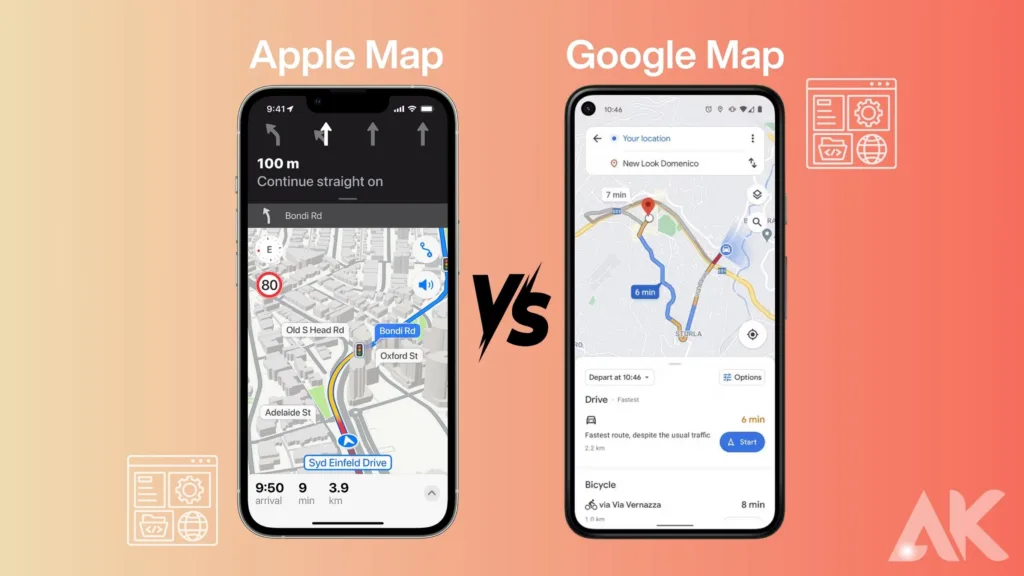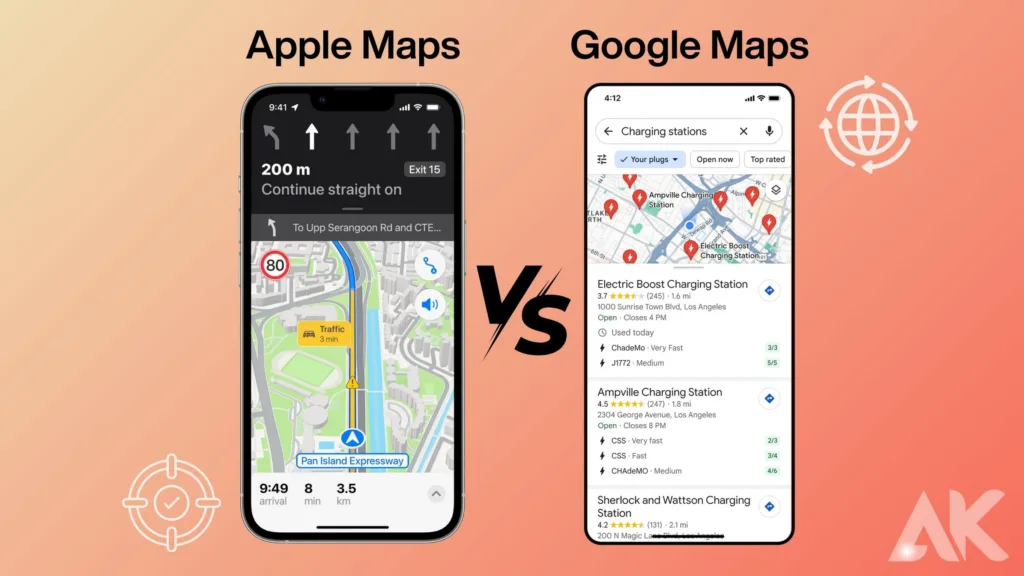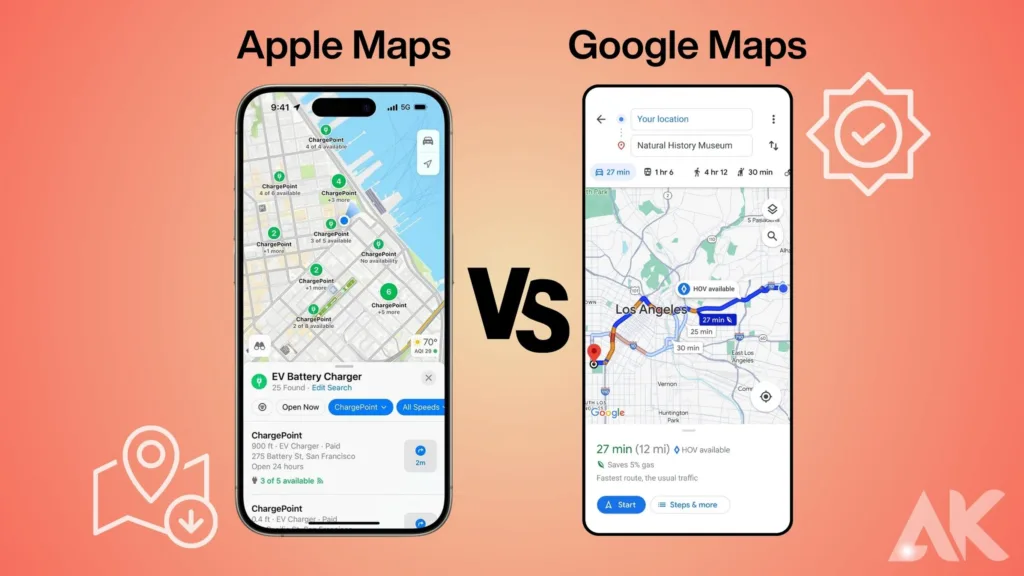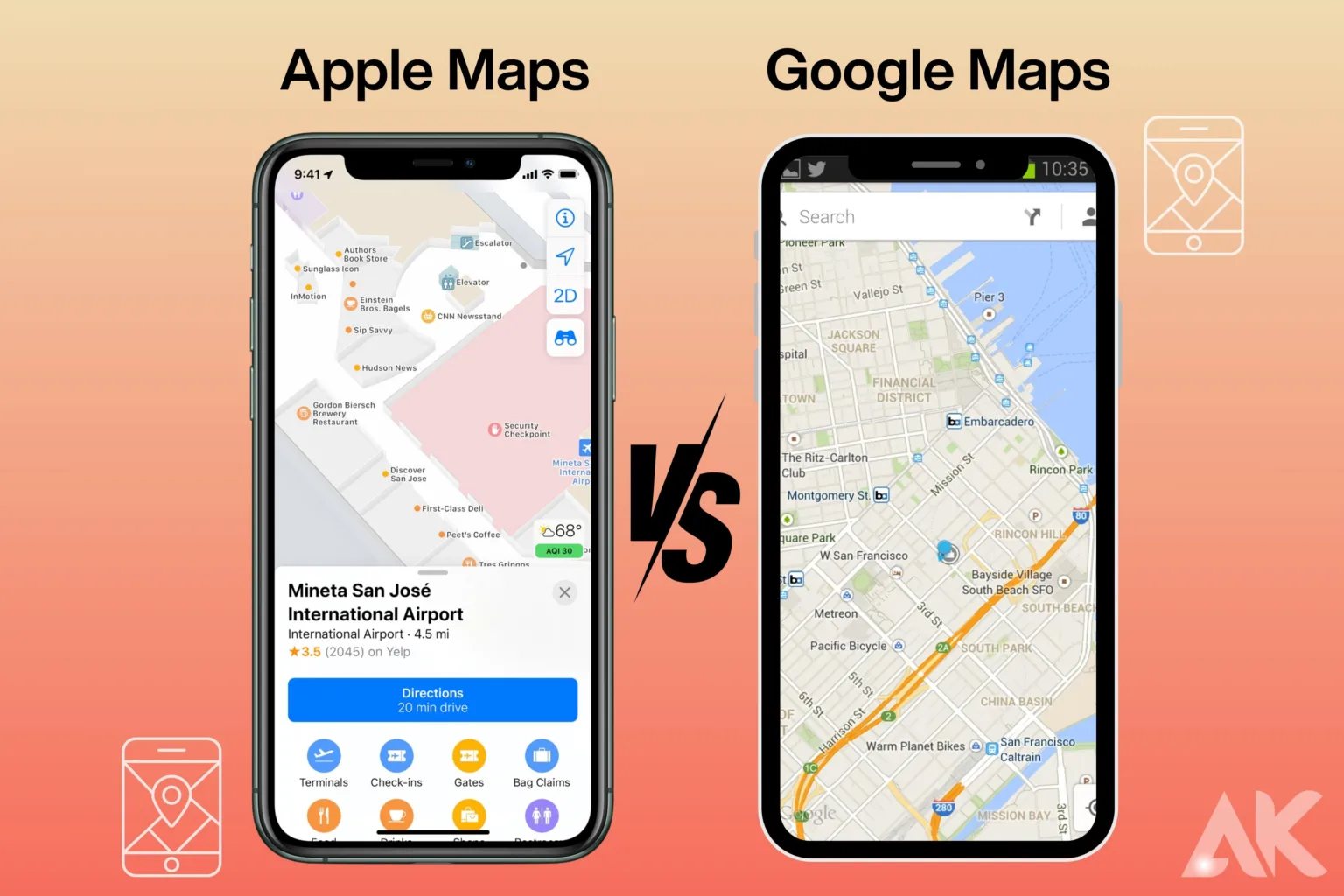Apple Maps vs Google Maps When it comes to navigation apps, Apple Maps and Google Maps are two major players with advantages and disadvantages. Apple created Apple Maps, which comes pre-installed on all Apple devices, including iPhones, iPads, and Macs. It has a simple and clean interface, integrates with other Apple services, and has features like The Flyover, which offers 3D views of some cities.
On the other hand, Google created Google Maps, which is well-known for its extensive map coverage, real-time traffic updates, and Street View feature, which enables users to virtually explore locations. Both apps have devoted user bases, but which one is the best? Let’s examine its features, accuracy, and ease of use to decide which navigation app is right for you.
User Interface and Ease of Use

Apple Maps vs Google Maps have different user interface designs. Apple Maps features a simple, plain interface, focusing on clarity and simplicity. The app’s large, clear letters and symbols make it simple for users to understand and use. On the other hand, Google Maps boasts a more feature-rich design with an array of options and details presented on the screen.
Some users may find this overwhelming, but others value having so much information at their fingertips. Both applications provide easy-to-use controls and seamless navigation. When it comes to seamless integration, Apple Maps works with other Apple services, like CarPlay for in-car navigation and Siri for voice requests. In contrast, Google Maps’ search feature set is excellent, making it simple to locate particular places, businesses, and sites of interest.
To sum up, the decision between Apple Maps vs Google Maps primarily comes down to personal taste and the features that are most important to you. Apple Maps might be the better option if you want a clear and uncomplicated UI that works smoothly with other Apple products. But Google Maps might be a better fit for you if you value extensive map coverage, real-time traffic updates, and a plethora of other features.
Map Accuracy and Coverage

The coverage and quality of the maps are important considerations when selecting a navigation app. While both Apple Maps vs Google Maps aim to offer exact and current maps, there may be differences in their coverage and data sources. Google Maps is known for having a wide range of maps, including in-depth information about businesses and places of interest as well as detailed maps of inaccessible locations. Google uses a range of sources to collect its mapping data, including user remarks, Street View vehicles, and satellite photography, all of which improve the accuracy and comprehensiveness of its maps. In contrast,
Apple Maps has substantially improved map coverage and accuracy over time by using data collected from its fleet of vehicles outfitted with modern mapping technology. Still, a few users sometimes point out errors or missing data in Apple Maps, especially in rural or less populated areas.
Both Apple Maps and Google Maps perform well in populated and frequently visited locations when it comes to real-world accuracy, offering precise instructions and projected arrival times. However, because of its many data sources and user contributions, Google Maps typically has more accurate and up-to-date information in less populous or rural areas. With constant improvement, Apple Maps can still be inferior to Google Maps in several areas. In the end, your particular demands and geographic area will determine which map accuracy and coverage provider is better—Apple Maps or Google Maps.
If you travel to isolated or sparsely populated places regularly, Google Maps might be a better bet. Nonetheless, both applications ought to offer precise and dependable guidance if your travels are mostly made in populated or well-travelled locations.
Navigation Features Apple Maps vs Google Maps

Apple Maps vs Google Maps provide an extensive range of navigational options to assist users in getting from one place to another. Turn-by-turn navigation, transit information, and real-time traffic updates are just a few of the many features that make Google Maps so popular. Additionally, it has features like offline maps—which are handy when travelling in places with spotty connectivity—and street viewpoints, which let users see a 360-degree perspective of their surroundings.
To offer a more smooth management experience, Google Maps now connects with other Google services, such as Google Calendar and Google Assistant.
In contrast, Apple Maps has been gradually enhancing its navigation functionalities and currently provides a plethora of identical options to Google Maps. Along with interaction with Siri for voice commands, it offers real-time traffic updates, turn-by-turn navigation, and transportation information. In addition, Apple Maps has special capabilities like Flyover, which lets users see some cities in three dimensions, and Indoor Maps, which lets users go about within shops and airports.
Furthermore, Apple Maps places a high priority on user privacy by anonymizing data and, when feasible, utilizing on-device processing.
Traffic Updates
Any navigation app must have traffic updates since they enable users to avoid traffic while finding the quickest route to their destination. Real-time traffic information is available on both Apple Maps and Google Maps, although there are differences in the data collection and display methods. Thanks to a variety of data sources, including past traffic data, user reports in real-time, information from partners and government departments, and more, Google Maps is renowned for providing precise and thorough traffic updates. As a result, users can avoid any delays by using Google Maps, which can offer up-to-date information about traffic conditions, including accidents, construction, and road closures.
Over the years, Apple Maps has also improved its traffic updates, using information from iPhones and other Apple products to deliver real-time traffic updates. When feasible, Apple Maps processes this data on-device to ensure user privacy is protected.
Even though Apple Maps might not be as accurate or detailed as Google Maps, it nevertheless offers helpful traffic data to make route planning easier for users. In the end, your unique requirements and tastes may determine which traffic update app you prefer—Apple Maps or Google Maps. Google Maps might be a better option if accurate and in-depth traffic information is important to you. On the other hand, Apple Maps might be a better option for you if privacy and integration with other Apple services are important to you.
Offline Maps
For travellers or anybody exploring places with spotty or no internet connectivity, offline maps are a useful tool. Users can download maps of particular regions or locations for offline use using the offline map features offered by both Apple Maps and Google Maps. With its more feature-rich offline mapping function, Google Maps enables users to download maps for whole nations or regions and get turn-by-turn navigation even when they’re not connected. When offline, users may still look up addresses and learn about nearby companies and attractions.
Similarly, Apple Maps vs Google Maps has offline map functionality, however, it is more constrained. Though not as feature-rich as Google Maps, users can download maps of specific areas for offline use. In addition, users will have to rely on previously downloaded maps and do manual navigation when offline because Apple Maps does not presently enable offline turn-by-turn navigation.
While both Apple Maps vs Google Maps Maps may be used offline, Google Maps offers a more feature-rich and complete offline navigation experience. Google Maps can be a better option if you value offline mapping and navigation. Apple Maps, however, might still be able to satisfy your offline mapping needs if you value interaction with other Apple services and use Apple devices solely.
Integration with Other Apps and Services
Navigate apps should integrate with other apps and services because this can improve the user experience overall and offer ease. In this regard, Google Maps sparkles, offering smooth connectivity with an extensive array of Google services as well as other applications. Google Maps, for instance, may be integrated with Google Assistant for voice-activated navigation, Google Photographs to show tracked photographs on the map, and Google Calendar to provide directions to upcoming activities.
Google Maps is a one-stop shop for all transportation needs because it enables users to book trips with services like Uber and Lyft straight from the app.
In terms of integration with other apps and services, Apple Maps currently trails Google Maps, even if it has made progress in this area. Although Apple Maps lacks the extensive third-party app connectivity that Google Maps offers, it does connect with Siri for voice-activated navigation and with Apple CarPlay for in-car navigation. In addition, Apple Maps has started to provide more interfaces with services, such as OpenTable for restaurant bookings and Yelp for business evaluations, but these integrations are not as complete or smooth as those provided by Google Maps.
Privacy and Data Collection
When selecting a navigation app, privacy and data gathering are crucial factors to take into account because they might affect the security of your data. The ways that Google Maps and Apple Maps handle data collection and privacy differ. Apple Maps places a high priority on user privacy by utilizing on-device processing whenever feasible and hiding data. For instance, the information you enter into Apple Maps to find a place or plan a journey is encrypted and does not individually identify you. Apple Maps significantly improves user privacy by not collecting user data for advertising.
On the other hand, to enhance its features and offer personalized experiences, Google Maps collects a substantial quantity of user data, including location history, search history, and interactions with the app. Although Google Maps gives users the ability to modify their privacy settings and remove their data, some users might be worried about the volume of data gathered and how it will be used for marketing. But Google Maps also makes use of this information to offer features that can improve the user experience overall, such as personalized recommendations and real-time traffic updates.
The decision between Apple Maps vs Google Maps in terms of collecting information and privacy ultimately comes down to personal preferences and the degree of comfort with sharing personal data. Given its focus on user privacy and data anonymization, Apple Maps might be a superior option if privacy is your primary concern. However, thinking about its wealth of features and capabilities, Google Maps can still be a good choice if you value personalized experiences and feel comfortable sharing some data.
Availability and Compatibility
When selecting a navigation app, compatibility and availability are important factors since they dictate whether the app will function on your devices and in your current location. There are differences in the accessibility and compatibility of Apple Maps and Google Maps, even though both are extensively accessible and suitable for a range of devices.
All Apple products, including Macs, iPads, iPhones, and Apple Watches, have access to Apple Maps. It offers a smooth user experience across many devices and is strongly integrated into the Apple ecosystem. It is pre-installed on these devices. However, since Apple Maps cannot be accessed on non-Apple devices, consumers who use a variety of devices made by different manufacturers may find it less helpful.
In contrast, Google Maps can be accessed on desktop computers via a web browser and on Android and iOS smartphones. Because Google Maps can be used on several devices independent of the manufacturer, it is more generally accessible than Apple Maps. To further improve its availability and compatibility, Google Maps also provides a web version that can be used from any device with an internet connection.
Conclusion
Apple Maps vs Google Maps are useful navigational aids because of their many features and functionalities. For individuals who place a high value on privacy and seamless integration with other Apple services, Apple Maps is an excellent option. On the other hand, Google Maps is a flexible choice for a variety of customers due to its broad map coverage, real-time traffic updates, and easy connection with third-party applications.
In the end, which map app you use—Apple Maps or Google Maps—depends on your personal preferences and needs. If Apple is your primary device of choice and privacy is important to you, Apple Maps might be a better option. But if you value having a wide range of features and being compatible with multiple devices, Google Maps might be a better fit for you.
FAQ
Q1: Is Apple Maps vs Google Maps more accurate?
Google Maps is generally considered to be more accurate, especially in remote or less populated areas.
Q2: Which navigation app has better traffic updates?
Google Maps is known for its comprehensive traffic coverage, but Apple Maps has been improving its traffic data and is now comparable in many regions.
Q3: Can I use Apple Maps on an Android device?
No, Apple Maps is only available on Apple devices. Android users can use Google Maps, which is available on both Android and iOS devices.
Q4: Does Apple Maps vs Google Maps offer better integration with other apps and services?
Apple Maps integrates seamlessly with other Apple services, while Google Maps offers integration with a wide range of third-party apps and services.
Q5: Which navigation app is more user-friendly?
Apple Maps is often praised for its simplicity and ease of use, while Google Maps is favoured for its depth of information and advanced features.

